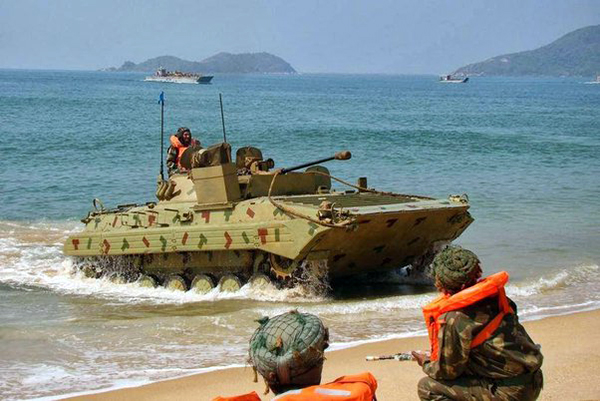
India’s mechanised infantry is on the threshold of a critical transformation, with the army setting a brisk pace to equip its vital combat arm with a range of new indigenous capabilities ranging from futuristic vehicles, missile systems and night-fighting gear to loitering munitions, anti-drone weapons, and intelligence, surveillance and reconnaissance (ISR) platforms.
The comprehensive road map for its modernisation seeks to transform the mechanised infantry into a more lethal, agile and integrated force capable of delivering a swift and effective response in battle.
The army will seek the defence acquisition council’s acceptance of necessity (AoN) for the FICVs at the earliest. It is simultaneously pursuing modernisation plans for tracked and wheeled vehicles.
BMP-IIs are the Backbone
Forming the core of the overarching capability enhancement plan – dovetailed with the Aatmanirbhar Bharat (self-reliant India) strategy – is the replacement of the BMP-IIs with 480 locally developed futuristic infantry combat vehicles (FICVs) for which government approval will be sought shortly.
The Army has initiated trials involving three private Indian companies for the upgrade of the over 2,500 Russian Infantry combat vehicles – BMP II – that have been in service since the late 1980s, to give them night fighting capabilities as well as anti-drone measures besides a high-power engine.
The army has already secured approvals for the Nag missile system (NAMIS) for reconnaissance and support battalions (13 Nag missile carriers and 293 missiles), 177 infantry combat vehicles (command), and 105 wheeled armoured fighting vehicles to replace Soviet-origin BRDM reconnaissance vehicles and 1080 anti-tank guided missiles.
Also on the mechanised infantry’s wish list are wheeled infantry combat vehicles for standard battalions and light armoured multi-purpose vehicles with enhanced mobility and protection for reconnaissance platoons that currently use the Maruti Gypsy.
The modernisation drive will enhance the mechanised infantry’s mobility and effectiveness, and also boost India’s capabilities along the northern borders with China.
A threat cum capability-based modernisation approach is being pursued with the acquisition of contemporary, adaptable and niche technology, which is interoperable with other combat arms.
Capability enhancement of existing military hardware with upgrades for night fighting, lethality and ISR systems forms an important element of the modernisation effort.
Night Fighting Capability
Enhanced night fighting capability is a top priority. The focus is on a comprehensive solution for the gunner main sight, commander panoramic sight, fire control system, automatic target tracker and laser range finder. The new gear will enhance the night vision capability of the driver and commander too.
The BMP, being manufactured by the state-owned Ordnance Factory Medak under license from Russia, lacks night-vision capability, literally leaving it blind when the sun sets, or when there is smoke, dust or fog. Hence, the Army was keen on an upgrade even as it pursues a different programme for Futuristic Infantry Combat Vehicle (FICV) that will replace these BMPs.
The programme is being pursued through the government’s iDEX (Innovation for Defence Excellence) initiative in which three firms have qualified.
The three firms, sources said, in contention are Tonbo Imaging, Big Bang Boom and Dimensions NXG.
The see-through armour is going to be a big technological leap that will increase situational awareness. “See through armour” that provides the commander, his driver and the gunman a 360-degree view even at night. The technology enhances the vehicle’s all-round survivability and provides an extra edge in combat.
The solution for BMPs’ weakness comes through cameras and magnetic trackers. The BMPs will be fitted with over half a dozen cameras which will be integrated with a helmet display. This will mean that when the commander turns right, the headgear displays images of the surroundings onto the insides of the tank as if he was seeing through the armour. A magnetic tracker senses the head movement of the wearer and displays video from the same direction.
Adding to the capability is that the driver’s head-mounted display can also interface with the GPS system for precise manoeuvring and situational assessment. This meant the commander was able to see a wider coverage of possible targets and threats.
Enhancing Firepower
Enhancing fire power of mechanised infantry units is covered under the plan, and is a work in progress.
This is being done through third generation fire-and-forget anti-tank guided missiles, canister-launched loiter munition systems integrated on the BMP-II chassis, anti-drone capability, and integrated surveillance and targeting systems.
ISR capability is being strengthened with mini-unmanned aerial vehicles, see through armour for better situational awareness, autonomous combat vehicles and artificial intelligence-based integrated surveillance, detection and engagement systems.
India’s mechanised forces – the mechanised infantry and armoured corps – are also inducting swarm drone systems capable of carrying out offensive missions in enemy territory with scores of drones working in formations to identify, encircle and strike targets.
Other upgrades planned on BMPs
Given the changing warfare scenario, there is a requirement to equip the army’s Mechanised Infantry with state-of-art missiles and lethal capability beyond visual range (BVR). This includes the Fire and Forget Anti-Tank Guided Missiles (ATGMs).
Multiple indigenous options are being explored to equip the Mechanised Infantry with contemporary third-generation Fire and Forget ATGM, including ones being developed in India.
Another acquisition planned is that of the Canister Launched Loiter Munition System integrated on BMP 2/ Carrier Mortar Tracked (CMT) chassis.
To enable anti-drone capability on existing equipment, changes in aerial sight for effectively exploiting the ability of stabilised and automatic 30 mm Cannon and co-axially mounted 7.62 mm Machine Gun (PKT) to engage aerial targets is being pursued.
FICV in Phase 2
For the Mechanised infantry, sources said, the Army is following a twin approach – replacement of vintage equipment with futuristic platforms and capability enhancement of existing equipment through upgrades for enhancing night enablement, lethality, intelligence, Surveillance and Reconnaissance (ISR) capability.
The acquisitions planned in the tracked category includes the FICV that will replace BMP 2.
The Army is also procuring the New Wheeled Infantry Combat Vehicle (Wh ICV) for standard mechanised infantry battalions (Wheeled) and is also seeking a Light Armoured Multi-Purpose Vehicle (LAMV) with enhanced mobility and protection for Recce Platoon to replace the existing modified Maruti Gypsy.

















